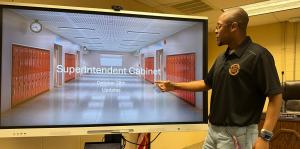
Superintendent Anthony leads a strategy session to align district goals, emphasizing the importance of standardized procedures and collaboration.
Superintendent Anthony shares practical leadership strategies for reducing variability in schools through trust-building and standard operating procedures.
ATLANTA , GA, UNITED STATES, November 19, 2024 /EINPresswire.com/ -- Introduction
Leadership in education is a calling, and for those who step into the roles of principal or superintendent, the challenges can feel insurmountable. As a new superintendent of Hancock County Schools, he has quickly learned that the key to turning any learning institution around lies in reducing variability in instruction and operations. The way to achieve this is through Standard Operating Procedures (SOPs)—clear, consistent guidelines that create alignment across schools and classrooms.
In this article, superintendent Anthony shares insight from his first year as a superintendent, practical strategies for leaders, and research-backed approaches to drive improvement. Whether you’re an aspiring leader or an experienced one seeking new perspectives, his hope is that this piece equips future leaders with actionable tools to succeed.
1. Observe First: The Power of the First 90 Days
Before making sweeping changes, take 90 days to observe. Change for the sake of change alienates stakeholders; targeted change builds trust. Use this period to identify what plagues your district or school. Pay attention to patterns, and ask yourself not just “What’s wrong?” but “What’s causing these issues?” By understanding the root of the problem, you can implement solutions that stick.
For instance, we discovered that each school in the district operated under “unwritten rules.” These informal systems bred inconsistency in instruction and discipline. Without district-wide non-negotiables, documenting teacher or student misbehavior was nearly impossible. This lack of standardization revealed a need for clear SOPs.
2. Visibility: Building Trust Through Presence
Leadership isn’t about command and control; it’s about relationships. During those first 90 days, he prioritized being visible. By showing up at schools, engaging with teachers, parents, and students, and actively listening, he demonstrated that he wasn’t a threat but a teammate. Trust-building is foundational—it allows you to gain buy-in for the changes that will follow.
3. Implementing SOPs: A Game-Changer for Reducing Variability
After observing and building trust, it was time to implement Standard Operating Procedures. SOPs ensure consistency, clarity, and fairness. They reduce the variability of instruction and operations, giving principals and teachers a roadmap to follow.
Here’s a look at a key SOPs we implemented in Hancock County Schools:
Teacher Discipline SOP: Building a Culture of Excellence and Accountability
The Teacher Discipline SOP is a progressive three-step framework designed not only to address teacher behavior but also to foster a culture of excellence and accountability across the district. By providing clear expectations and actionable steps for improvement, it empowers teachers to focus on instructional quality while ensuring fairness and consistency.
This SOP reinforces a standard of high performance by prioritizing professional growth through targeted interventions like weekly case studies, video reflections, and structured feedback. At the same time, it holds everyone accountable for their role in student success, ensuring that only those committed to the mission of excellence remain on the team.
By addressing underperformance and supporting improvement, the SOP creates an environment where every educator contributes meaningfully, removing those who do not align with the district's goals and values. This approach not only strengthens instructional practices but also builds a unified, high-performing team committed to driving student achievement.
4. Addressing Teacher Variability: The Non-Threatening Approach
One of the greatest challenges for any leader is addressing teacher performance. Rather than taking a punitive approach, he focused on supportive accountability. For example, teachers on PDPs temporarily step back from extracurricular responsibilities, such as coaching, to prioritize instructional improvement. Weekly improvement activities, such as case studies and video analysis, provide structured opportunities for growth.
This approach aligns with John Hattie’s research on effective teaching practices. Consider these high-impact factors:
Teacher Clarity (0.75 effect size): Clearly communicating learning objectives and expectations enhances student engagement and performance.
Feedback (0.70 effect size): Constructive feedback helps teachers improve, just as it does students.
Collective Teacher Efficacy (1.39 effect size): When teachers believe in their collective ability to improve student outcomes, schools thrive.
5. Gradual Change Yields Lasting Results
Change is hard. As a leader, he learned that gradual change is the key to acceptance. By focusing on foundational practices—like standardizing teacher and student discipline procedures—we’ve created a culture of consistency without overwhelming staff.
For example, implementing district-wide non-negotiables like punctuality, respectful communication, and grade updates allowed us to align expectations across schools. These small but significant changes are paving the way for larger transformations.
6. Leadership Lessons: What he Wish he Knew
Looking back, he wish he understood the importance of SOPs from day one. Without clear guidelines, even the most talented leaders and teachers struggle to create a cohesive system. For those stepping into leadership roles, my advice is simple:
Start with trust. Be visible, listen actively, and build relationships before implementing change.
Focus on the root causes. Don’t just address symptoms—understand the underlying issues.
Standardize for success. Create SOPs that reduce variability and provide clarity for staff at all levels.
Conclusion: The Leader’s Call to Action
Leadership is about reducing variability—not just in instruction but in operations, expectations, and culture. By observing, building trust, and implementing SOPs, you can create a system where every school, teacher, and student has the tools they need to succeed.
For aspiring and current leaders: remember, it’s not about knowing all the answers but about setting up systems that make finding those answers possible. Together, let’s build schools where consistency leads to excellence.
About the Author
Dr. Anton Anthony is the superintendent of Hancock County Schools and an advocate for educational transformation. He has authored two books, "Loving Education: Restoring the Heart of Education" and "STEAMpreneurship: Through Interdisciplinary Experiential Entrepreneurship
Superintendent Anton Anthony
Hancock County Schools
email us here
Legal Disclaimer:
EIN Presswire provides this news content "as is" without warranty of any kind. We do not accept any responsibility or liability for the accuracy, content, images, videos, licenses, completeness, legality, or reliability of the information contained in this article. If you have any complaints or copyright issues related to this article, kindly contact the author above.



